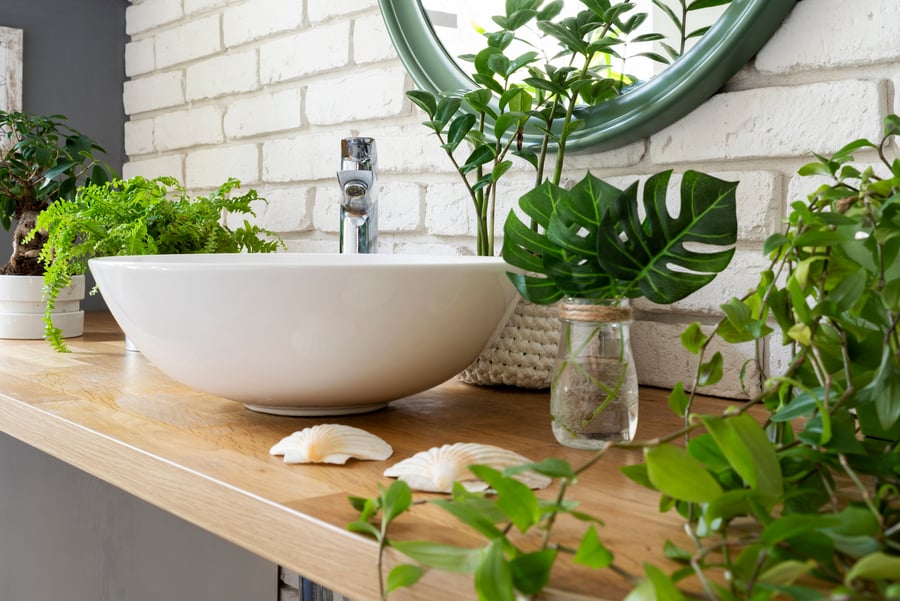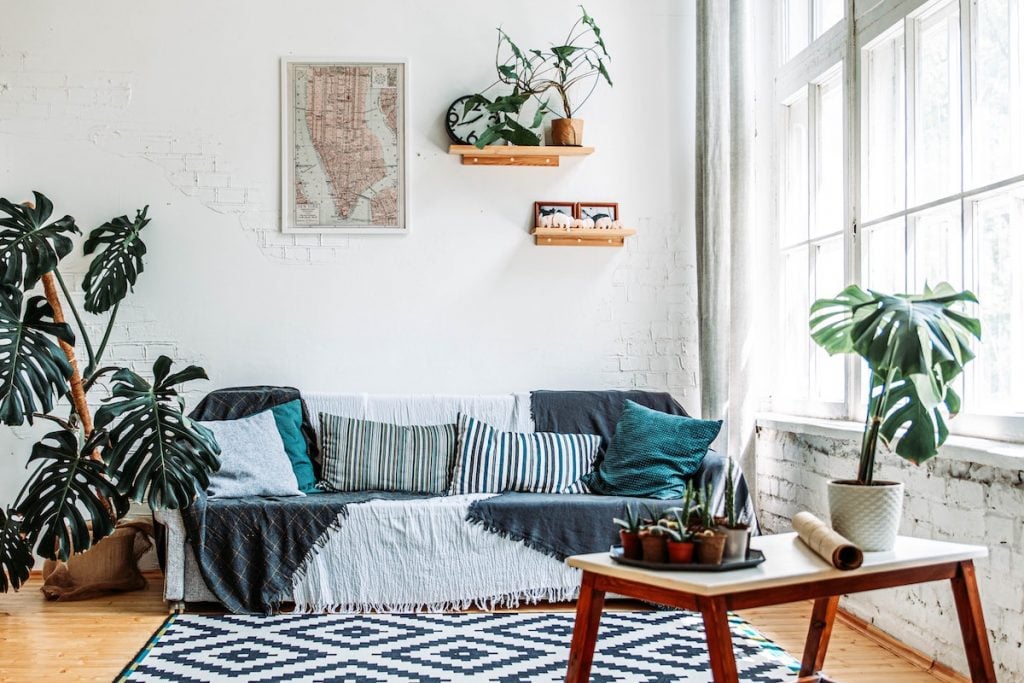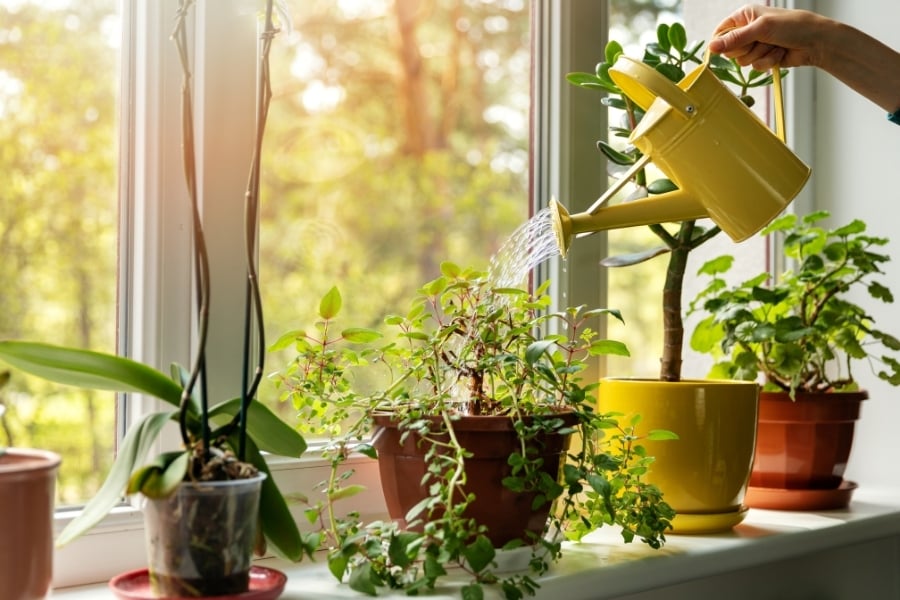Biophilic design has been a trendy buzzword in the interior design world for the last decade. Although the term is a relatively new concept, experts have discovered it in architectural styles dating as far back as Babylon’s Hanging Garden and elsewhere.
Generally, biophilic design strategies refer to the integration of the natural world into man-made interior spaces and urban environments. It can be a direct experience of sensations from natural elements, such as a fountain in an urban park or plant walls in a commercial office.
But light and space conditions, such as skylights and using natural geometries to mimic nature, are also important in biophilic design and can impact us in a number of positive ways.
If you’re looking to improve the biophilic design of your space, indoor plants are a great way to start. Especially when paired with air-purifying plants, pots and containers are great for adding color and dimension to any room.
Why biophilic design is relevant now
The health benefits of biophilic design have been well-researched in the scientific community over the last several years.
It is widely known by now that incorporating the natural environment into our homes and offices can reduce stress, enhance cognitive performance and creativity, and increase general health and well-being.
And as the world population grows and economies around the world flourish, these qualities are becoming increasingly important in commercial settings. Given that US companies waste billions of dollars annually on lost productivity as a result of stress-induced ailments, and considering how quickly a connection with nature can provoke a restorative response, it’s no wonder biophilic spaces are becoming the new future of the modern built environment.
But the connection with nature is also important in our daily home life as well. Especially for those living in big cities, our homes and workspaces no longer depend on natural materials derived from the region and do not reflect the area’s climate and culture.
So whether you’re living in the desert or in a city with a Mediterranean view, incorporating biophilic design elements in your interior spaces is sure to have a positive impact on your life, even in the most subtle ways.
There are other styles for you to consider too, check out our guide to Zen garden ideas for inner peace, desert landscaping ideas, or Southern California landscaping ideas!
What is biophilia?

Everyone knows that feeling. The warm, coziness of a crackling fire. The relaxing sound of a babbling brook. The rush of energy that follows after you catch a cool breeze.
We can attribute these pleasant experiences to a phenomenon known as biophilia.
In Greek, the term literally translates to ‘love of life’, and we see this philosophy take many shapes and forms in our everyday lives, from interior to architectural design, and even urban landscape design.
Popularized by biologist Edward Wilson in the 1980s, the biophilia hypothesis argues that interaction with the natural world is critical for human health and well-being. Although there is already plenty of evidence to suggest that biophilic spaces improve human health and enhance well-being, scientists and experts are still just scratching the surface of understanding the powerful human-nature connection that produces these physiological, mental, and social reactions from natural systems.
What is the biophilic design concept?

In our view, biophilic design has two main functions: those pertaining to humans and those relating to the earth we live on. Nowadays, we spend about 90% of our time indoors, so bringing nature back to indoor spaces has been the priority of biophilic designers since the philosophy gained traction in the 1980s.
Throughout this article, biophilic design refers mainly to utilizing natural stimuli in interior spaces, both directly and indirectly. From air-purifying plants and living walls, to flooring and furniture, the goal is to improve the indoor air quality, as well as improve mood and efficiency amongst occupants whilst minimizing stress levels.
But true biophilic design incorporates sustainable design practices to reduce negative environmental impact to a minimum and ensure happiness and health for all life. For example, cities like Singapore have set goals to ensure that their urban environments are more interconnected with nature by 2030. Initiatives to increase access to parks and incorporate more greenery along the streets not only benefits humans, but also the animals and other small life that make up the entire ecosystem of the area.
5 Biophilic Design Principles to Improve Any Space
1. Integrating the five senses with the natural world

Good biophilic design is meant to stimulate as many of the five senses as possible. A multisensory interior space inspired by nature provides the most opportunities to receive the positive benefits of biophilic design strategies.
For example, take a glass window. In a family house, this is an indisputable feature to include in the design. Not only does a summer breeze feel great and improve air circulation in the home, but it allows us to hear singing birds and falling rain, which is linked to weather and the seasons.
But when people are unable to open the windows in their home or office, this limits the sensory experiences that this design feature can bring. Sure, we can see the birds flying and the rain falling, but there is still some degree of separation which makes for poor biophilic design.
Almost all of the following biophilic design principles that we mention will stimulate your visual senses in one way or another, but the goal of biophilic design is to create a cohesive space that provides those positive benefits.
One way to do this is to create a central focal point of your interior space, the place where your eyes are immediately drawn. Oftentimes this already exists in your space and you just need to highlight it, such as a large window overlooking a natural landscape or a stone hearth fireplace. You can also use other design features, such as furniture or artwork, to create visual stimulation.
If this seems like a foreign concept to you, an interior designer or biophilic design consultant can help you figure out and plan the best features to draw attention to in your home or office space.
Since good biophilic design incorporates not only sight, but all five senses, it’s a good idea to incorporate natural features that produce sounds and smells as well.
Natural sound recordings can be found just outside the window or on YouTube, and including seasonal variations adds more diversity for our auditory senses. Biophilic interior design also integrates sound-absorbing solutions for acoustic comfort such as acoustic panels, moss walls, privacy booths and eco flooring panels.
Additionally, diffusing essential oils can help enhance and regenerate your senses in an intense multisensory environment.
2. Using indoor plants in biophilic design interiors

Biophilic designers have long been fascinated by everything green and leaf!
Whether in a vertical garden or a pot, suspended from the ceiling or embedded inside wall dividers, plants are a major biophilic feature that you don’t want to overlook when designing your space. Indoor plants have the capacity to stimulate nearly all of our senses and are a daily reminder to literally “stop and smell the flowers”.
Air purifier plants help reduce carbon dioxide levels and provide natural calming properties for indoor space. But whether their purpose is to improve indoor air quality or just produce beautiful blooms, plants are still one of the fundamental elements of biophilic design principles.
Vertical gardens, or living walls, are an effective tool for air-purifying and noise-reducing qualities. Green walls are much easier to install than you may think, and they are a wonderful addition to homes and offices. Even smaller plant wall fixtures can provide a dramatic improvement to the space’s biophilic design.
With the right light and water conditions, you can grow nearly any plant in a pot or container garden. No matter how much space you have, just one indoor container plant can provide the benefits of biophilic design. Although, there is some evidence that too much greenery, especially in the workplace, can overload our senses and wind up having the opposite effect on our mood and well-being. So you may want to look at plants with red leaves to make your place a bit more dramatic and different
Check out our home decor tips and tricks to upgrade your interior style game
3. Incorporating natural materials in a sustainable way

There is something so warm and inviting about a room with lots of natural fixtures. Whether its the rich brown color of the wooden ceiling fixtures, the luxurious leather furniture, or the stone hearth fireplace, the inclusion of natural materials in both architectural design and interior design cannot be understated.
The value system behind biophilic architecture consists of sustainable use of natural and sourced materials. And while its hard to change the architecture of an already-existing building without enlisting the help of some construction workers, there are still plenty of options for using sustainable organic materials like wood fiber, wool, leathers and stones in your interior décor.
One of the easiest ways to create a better material connection in your space is to add pieces of furniture and décor made of natural materials. Wooden furniture, leather seats, and glass sculptures are but a few routes to go down, depending on the needs and purpose of your space.
4. Embracing natural forms and patterns

If you take a look outside, you may notice that even the tallest trees aren’t totally straight. In fact, nature loathes straight lines and right angles. From ocean waves and rounded seashells, to intricate flower petals and leaves on trees, it’s easy to see that natural environments favor patterns, sequences, and forms.
While the reason why is still widely unknown in the scientific community, studies have shown that humans have a visual preference for biophilic forms and patterns. But unfortunately, due to the heavy industrialization and mass building of structures over the years, lots of older architecture has fallen victim to the plague of boring, straight lines.
Not every house and building is capable of including natural shapes to the structure, but they are a decorative and powerful way to connect us to the world. A space with natural patterns and forms will feel more interesting and comfortable, perhaps even captivating.
Fabrics, wallpapers, or flooring based on the Fibonacci sequence or the Golden Mean can create a long-lasting connection with nature in your space. Free-standing structures, such as artwork and sculptures, can also create some interesting patterns in your space without the need for any expensive remodeling projects.
5. Prioritizing natural lighting

Lighting is an underrated, but important aspect of biophilic design because its properties have the ability to affect our bodies in profound ways.
In the morning, blue light produces serotonin and, in the evening, the red light from the sunset triggers melatonin. These two hormones are responsible for your sleep cycle, or your circadian rhythm, and we have evolved over millions of years to respond poorly to disruptions in this cycle. Depression, anxiety, moodiness, fatigue, and trouble sleeping are symptoms that your circadian rhythm is off.
Spaces optimized to maximize biophilic design aim to work alongside the sun’s natural pattern of daylight. For example, smart lights with LEDs are capable of varying the brightness and intensity of the light in a daylight environment to mimic the body’s natural 24-hour cycle. The combination of natural light, including skylights and windows, and artificial light help create the perfect interior design for health.
However, overexposure to natural light can have some negative effects. For one, there is the issue of harmful UV rays from the sun, so if the sun is strong in your region or if you are particularly sensitive to UV rays, you may choose to limit natural light during the day.
Research also shows that too much sunlight in office spaces can be stressful for workers. This is where diffuse light comes in. Use solar shades or stylish linen curtains to filter the natural light, or floor lamps with adjustable arms to adapt to your lighting preferences throughout the day.
Learn more about how choosing the correct shape and size of planters improves plant health.
What are the benefits of biophilic design?

There is mounting evidence that biophilic design has a positive effect on human health. I can only speak for myself, but this doesn’t come as much of a surprise. After spending the better part of the last two years indoors, I now notice a considerable mood shift when I’m surrounded by natural elements like fresh air, natural light, and green life.
This isn’t by coincidence. Biophilic design impacts our bodies and brains on a physiological level, increasing cognitive function and psychological well-being, as well as promoting good overall health.
Interiors that feature biophilic principles can have the following benefits for its building occupants:
- Improved memory and concentration. In offices where repetitive tasks such as routine paperwork and data entry require a lot of mentally-intensive directed attention, biophilic design can reduce fatigue and improve overall productivity amongst workers.
- Better mood and emotional regulation. Even customers and other visitors can benefit from biophilic design in your home or office. Incorporating just a few natural elements into your space will reduce levels of cortisol, the stress hormone, leading to less anxiety, anger, and overall mental disturbance.
- Increase of overall well-being. In the long-term, exposure to biophilic elements in spaces where we spend a lot of time every day can have positive physiological impacts, such as lower blood pressure. Improved air quality can also reduce the risk of complications from lung-related illnesses.
What is a biophilic design consultant?

As biophilic design is meant to invoke a state of peace, the purpose of your environment is crucial to understanding the best way to maximize the benefits of your design.
For example, the bright light elements in your child’s school will look a lot different from the cozy, intimate light in your favorite restaurant. And since no two places are the same, a biophilic design consultant can help you decide which elements to include in your space to make the design more cohesive.
Biophilic designers are nationally recognized health-minded architects and interior designers who understand applications of interior, architectural, landscape and biophilic design and their benefits. Engineers, architects, lighting designers
In the case of a business project, it’s important that you have deep knowledge of health issues at the workplace. Hiring engineers and architects who understand the important role that building certifications such as BREEAM, WELL and FITWEL play in the integration of natural environments and built environments.
Conclusion

Biophilic Design combines nature and space conditions to provide a framework that enables thoughtful integration into built environments. This requires a combination of visual and non-visual elements, natural lighting, materials, and systems to create a cohesive experience of nature that works for the purpose of your space.
Overall, the most important factor to consider is the needs of your space and the people who will frequent it. Are you looking to get more work done in your home office, or subtly persuade people to buy more products in your shop? Your answer will play a huge part in figuring out what kind of design features to implement.
There are an endless number of options for incorporating natural elements into your space to create a multisensory experience, and you don’t need a large space or a huge budget to make improvements in your biophilic design.
Not sure about the first step to creating your own biophilic design? Start by shopping our fiberglass planters in a wide range of shapes and sizes.
